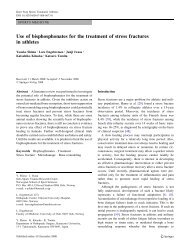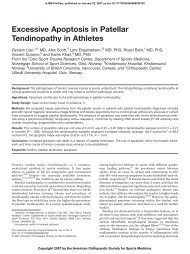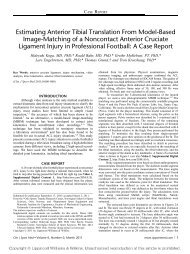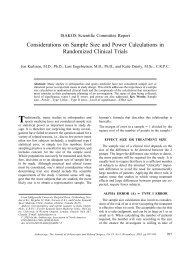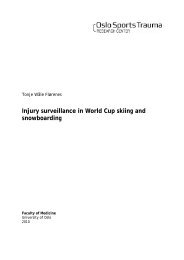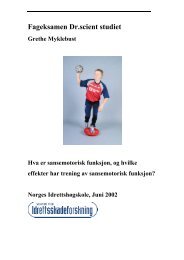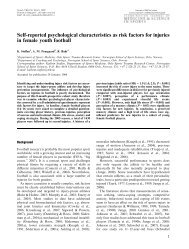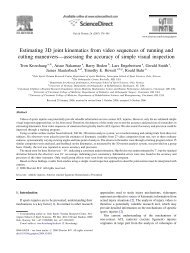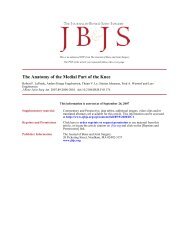ECSS Position Statement 2009: Prevention of acute sports injuries
ECSS Position Statement 2009: Prevention of acute sports injuries
ECSS Position Statement 2009: Prevention of acute sports injuries
You also want an ePaper? Increase the reach of your titles
YUMPU automatically turns print PDFs into web optimized ePapers that Google loves.
Downloaded By: [Steffen, Kathrin] At: 02:55 10 June 2010<br />
226 K. Steffen et al.<br />
mechanisms, <strong>of</strong> <strong>acute</strong> shoulder <strong>injuries</strong>, and hence for<br />
effective prevention strategies.<br />
Elbow<br />
Injury characteristics<br />
Acute elbow <strong>injuries</strong> are most common in (1)<br />
contact and collision <strong>sports</strong> (e.g. American football,<br />
rugby, and martial arts), (2) <strong>sports</strong> that place an<br />
athlete at elevated heights (e.g. high jump, ski<br />
jumping, and gymnastics), and (3) high-speed <strong>sports</strong><br />
(e.g. alpine skiing, speed skating, and cycling). Also<br />
<strong>sports</strong> such as weightlifting, boxing, shot put, and<br />
javelin place <strong>acute</strong> and heavy loads across the elbow<br />
joint during training and competition and expose the<br />
elbow to a potential injury risk. Athletes who fall on<br />
an extended elbow with the hand in full supination<br />
can suffer a number <strong>of</strong> injury types, including bone<br />
bruises, ligament strains, muscle contusions, and<br />
skin abrasions, and in the worst cases fractures and<br />
dislocations, and even injury to neurovascular structures<br />
(Hutchinson & Andrews, <strong>2009</strong>).<br />
Risk factors<br />
There is no evidence available on risk factors<br />
associated with <strong>acute</strong> elbow <strong>injuries</strong>.<br />
Mechanisms<br />
An <strong>acute</strong> elbow injury can occur via a direct impact<br />
to the elbow (e.g. by a fall or a collision) or by an<br />
indirect impact resulting in torques across the elbow,<br />
such as falling on an outstretched hand the classical<br />
injury description. When the elbow is hyperextended<br />
and when moments and forces are excessive, the<br />
collateral ligaments will rupture and damage the<br />
anterior capsule. If the forces continue, the elbow<br />
will dislocate. In judo, for instance, an athlete is<br />
allowed to place the opponent’s elbow in an elbow<br />
lock, a position <strong>of</strong> hyperextension. Indeed, if the<br />
athlete on the receiving end <strong>of</strong> this manoeuvre does<br />
not ‘‘tap-out’’ to concede defeat, continued force<br />
may lead to an elbow dislocation (Hutchinson &<br />
Andrews, <strong>2009</strong>).<br />
<strong>Prevention</strong><br />
There has been limited research on injury prevention<br />
methods, although it has been suggested that elbow<br />
<strong>injuries</strong> may be prevented through protective padding<br />
and education <strong>of</strong> athletes on how to fall<br />
properly (Hutchinson & Andrews, <strong>2009</strong>). Minimizing<br />
risk exposures and energy transfer during falls<br />
could be accomplished via rule enforcement, more<br />
severe penalties for violations, or rule changes. An<br />
example that has been shown to be effective was<br />
limiting the height <strong>of</strong> cheerleader towers, which, in<br />
turn, reduced the potential energy and risk <strong>of</strong> injury<br />
from falls (Boden, Tacchetti, & Mueller, 2003). In<br />
judo, banning the ability <strong>of</strong> a competitor to hyperextend<br />
the elbow and subsequently dislocate it until<br />
his opponent taps out (gives up) would likely reduce<br />
the risk <strong>of</strong> elbow <strong>injuries</strong> in judo (Hutchinson &<br />
Andrews, <strong>2009</strong>). Unfortunately, similar to traumatic<br />
shoulder <strong>injuries</strong>, there is limited evidence on how to<br />
prevent <strong>acute</strong> shoulder <strong>injuries</strong>. However, as for<br />
<strong>acute</strong> shoulder <strong>injuries</strong>, many <strong>acute</strong> elbow <strong>injuries</strong><br />
are simply accidents that occur during the routine<br />
performance <strong>of</strong> a high-risk sport.<br />
Hand/wrist<br />
Injury characteristics<br />
Sprains <strong>of</strong> finger and wrist joints as well as fractures<br />
<strong>of</strong> the wrist and fingers are typical in ball <strong>sports</strong> and<br />
other <strong>sports</strong> involving falling activities/accidents.<br />
Wrist fractures are common in snowboard <strong>sports</strong><br />
(Hagel, 2005; Langran and Selvaraj, 2004). Wrist<br />
<strong>injuries</strong> account for 8% <strong>of</strong> <strong>injuries</strong> among elite<br />
snowboarders (Torjussen & Bahr, 2005, 2006), and<br />
up to 32% among recreational boarders (Langran &<br />
Selvaraj, 2004; Machold et al., 2002). In less serious<br />
cases, falls result in sprains <strong>of</strong> the wrist joint (Hagel,<br />
2005). ‘‘Skier’s thumb’’ is a tear <strong>of</strong> the ulnar<br />
collateral ligament <strong>of</strong> the first metacarpophalangeal<br />
joint, leading to instability <strong>of</strong> the joint (Mogan &<br />
Davis, 1982), while volleyball players can tear<br />
the radial collateral ligament <strong>of</strong> the same joint<br />
when playing defence (‘‘volleyball thumb’’) (Bahr&<br />
Reeser, 2003). Most other finger <strong>injuries</strong> in, for<br />
example, volleyball and team handball are mild ligament<br />
<strong>injuries</strong> with which the athlete continues to train<br />
or compete, with or without exposed fingers taped.<br />
Risk factors<br />
Finger sprains take time to heal, and a history <strong>of</strong> a<br />
previous finger sprain exposes this finger to new<br />
<strong>injuries</strong>. Novice snowboarders are 23 times more<br />
likely to injure their wrist than experienced boarders<br />
(Goulet, Hagel, Hamel, & Légaré, <strong>2009</strong>; Langran &<br />
Selvaraj, 2004; Machold et al., 2002). Snow parks<br />
with half pipes, rails and jumps contribute to an<br />
increased risk <strong>of</strong> wrist sprains and fractures as a<br />
result <strong>of</strong> poor or overestimated physical and technical<br />
ability (Hagel, 2005).<br />
Mechanisms<br />
Complicated fractures <strong>of</strong> the wrist or forearm may<br />
occur as a result <strong>of</strong> a direct fall or <strong>of</strong> an unsuccessful



